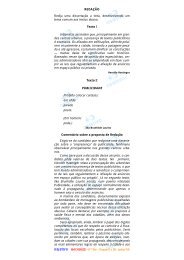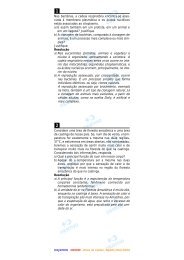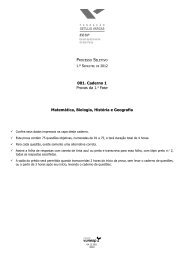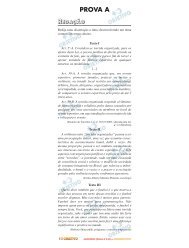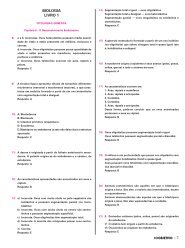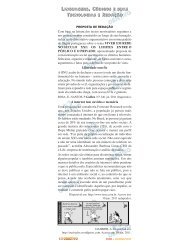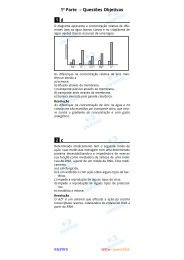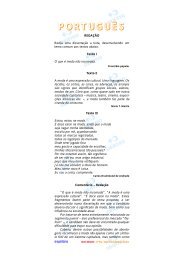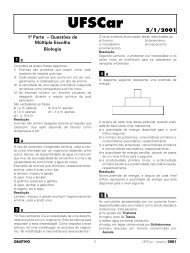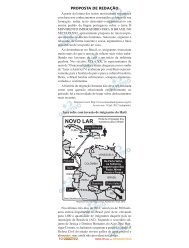2 D - Curso Objetivo
2 D - Curso Objetivo
2 D - Curso Objetivo
You also want an ePaper? Increase the reach of your titles
YUMPU automatically turns print PDFs into web optimized ePapers that Google loves.
3<br />
Paulo é pecuarista e possui um rebanho bovino de 1200<br />
cabeças, cuja taxa de crescimento anual é uma porcentagem<br />
representada por t. Paulo realizou a venda de<br />
1800 cabeças, comprometendo-se a entregar 1000 no<br />
final de 1 ano e, as outras 800, no final de<br />
2 anos.<br />
a) Determine t, considerando que, após a 2ª entrega,<br />
não sobre cabeça alguma.<br />
b) Se log 2 = 0,3 e t = 25%, quantos anos aproximadamente<br />
o pecuarista levaria para fazer a 2ª entrega?<br />
Resolução<br />
a) Se t for a porcentagem de crescimento anual do<br />
rebanho de 1200 cabeças que Paulo possui, então:<br />
1) Após a entrega feita, um ano depois, ele terá<br />
(1 + t) . 1200 – 1000 cabeças de gado.<br />
2) Após o segundo ano, Paulo terá<br />
(1 + t) 2 . 1200 – (1 + t) . 1000 cabeças e este número<br />
deverá ser igual a 800, de acordo com o enunciado.<br />
Assim sendo:<br />
(1 + t) 2 . 1200 – (1 + t) . 1000 = 800 ⇔<br />
⇔ 6(1 + t) 2 – 5(1 + t) – 4 = 0 ⇔<br />
5 ± 11<br />
16<br />
6<br />
⇔ 1 + t = –––––– ⇔ 1 + t = ––– ou 1 + t = – ––– ⇔<br />
12<br />
12<br />
12<br />
4<br />
⇔1 + t = –– (pois 1 + t > 0) ⇔<br />
3<br />
(<br />
100<br />
⇔ t = = % ––––)<br />
1<br />
––<br />
3 3<br />
b) Para t = 25%, temos:<br />
1) Após um ano, já feita a entrega, Paulo terá<br />
1,25 . 1200 – 1000 = 500 cabeças de gado.<br />
2) Após dois anos, ele terá 1,25 . 500 cabeças.<br />
3) Após três anos, ele terá 1,252 . 500 cabeças.<br />
4) Após n anos, ele terá 1,25n–1 . 500 cabeças.<br />
Assim sendo:<br />
1,25n – 1 . 500 = 800 ⇔<br />
n – 1<br />
(<br />
8<br />
⇔ = ⇔ (n – 1) . log = log ⇔ ––) (<br />
5<br />
5<br />
––)<br />
(<br />
5 8<br />
––<br />
5<br />
4<br />
––) 4<br />
⇔(n – 1) . (log10 – log8) = log16 – log10 ⇔<br />
⇔ (n – 1) . (1 – 3 . 0,3) = 4 . 0,3 – 1 ⇔<br />
0,2<br />
⇔ n – 1 = ––– = 2 ⇒ n = 3<br />
0,1<br />
OBJETIVO<br />
FGV - Administração - Junho/2006



